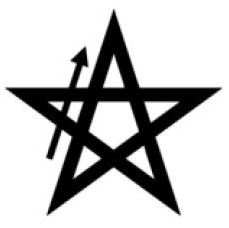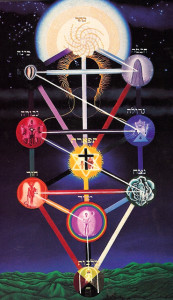“Those who regard this ritual as a mere device to invoke or banish spirits are unworthy to possess it. Properly understood, it is the Medicine of Metals and the Stone of the Wise.”—Aleister Crowley
If you have absolutely no interest in ceremonial magick, this probably won’t be anything that you’re interested in reading. If, however, you have even a mild curiosity about such things and/or practice any sort of meditation, you might find this to be something worth checking out and possibly implementing in your standard regimen. Personally, I’ve gotten some pretty good results with this. If you already practice some form of ceremonial magick, then you probably already know all about it…or at least you should. I wouldn’t try to stir up any kind of esoteric energy without using at least some form of opening ritual like this one. There are many others (including one that I really like but have been sworn to secrecy on), but the LBRP is by far the most common and recommended. Different groups and individuals have made some alterations to the ritual to suit their own interpretations of what it should be, but what follows here is, more or less, the standard format. You can add your own personal style and flare later on if you feel so inclined, but it’s best to stick to the recipe at first. Like improv comedy, you need to know the rules before you know when it’s okay to break them. Individual results may vary.
 This ritual was originally formulated by the Golden Dawn as an essential protective precursor to performing any other magickal operations. I suspect that they based it on something from at least one older system of magick, but I have nothing concrete to back that up. The bigshots in occult orders are pretty tight-lipped about such things. Regardless of where it may have originally come from, it has been adopted for use by a number of other orders. Clearly a lot of people in the field think that it has value.
This ritual was originally formulated by the Golden Dawn as an essential protective precursor to performing any other magickal operations. I suspect that they based it on something from at least one older system of magick, but I have nothing concrete to back that up. The bigshots in occult orders are pretty tight-lipped about such things. Regardless of where it may have originally come from, it has been adopted for use by a number of other orders. Clearly a lot of people in the field think that it has value.
So if that’s the case, one might wonder why there are so many variations in the ritual between sources. It’s partially because the original written instructions were ridiculously vague, and that was by design. Students were supposed to have a teacher to fill in the details. Also, that was a long time ago, and people were bound to change things to fit their own ideas of how it should be performed and what worked best. Most ceremonial magicians are a notoriously egotistical bunch and are quite certain that they know better than everyone else how things ought to be done. Most of them wouldn’t even argue with that statement.
Considering the past success that I’ve had using this ritual (which I’ll get to later), I was a bit surprised to find out subsequently that, according to at least some experts, I was doing some of it wrong. I was only a bit surprised because, like the chaos magicians, I tend to think that the most important aspect of “magickal” rituals is your intent and your state of mind. I wouldn’t necessarily rely on that assumption if I were performing some operation that could be potentially dangerous, but I’ve never ventured into those realms and have no plans to do so. To me, my success despite my apparent ignorance can all be summed up by the subtitle of Lon Milo DuQuette’s book Low Magick: It’s All in Your Head…You Just Have No Idea How Big Your Head Is. Pondering that concept might give you some insight into how these things work, assuming that they do.
The actual ritual is pretty simple. It consists of three parts: the Kabbalistic Cross, the Formulation of the Pentagrams, and the Invocation of the Archangels. There are some minor differences between just about every source out there (another reason that I wasn’t too worried about my “mistakes”), but the basic ritual is always the same. The version given below was taken primarily from what I consider to be a reliable and fairly neutral source. Make modifications at your own risk, although God doesn’t seem to be a real stickler for how you pronounce His names, probably because no one really knows. All of the variations are just different people’s best guess. I still just call Him Gary.
Part 1: The Kabbalistic Cross
For this most basic form of the ritual, it is usually recommended that you have some sort of altar in front of you on which you have lit a single white candle. Things can get far more elaborate later on, but when you’re just starting out, this is all that you really need.
Stand facing east. Visualize a pure white light floating just above your head. Using your right index and middle fingers or a steel dagger, touch the light and bring it down and your forehead and say ATEH (Thou art).
Move your fingers (or dagger) down to your chest and say MALKUTH (the kingdom).
Touch your right shoulder and say VE-GEBURAH (and the power).
Touch your left shoulder and say VE-GEDULAH (and the glory)
Fold your arms across your chest with your palms on your shoulders and say LE-OLAM (forever).
Clasp your hands together in front of your chest and say AMEN.
Part 2: The Formulation of the Pentagrams
 Still facing east, draw a pentagram in the air with your fingers starting from the bottom left point and moving diagonally up. (It’s the same way most of us have been drawing stars since we were kids. The generally recommended size is a shape that extends from your hips up to the top of your head.) As you draw it, visualize the lines as being bright blue, like the blue of a gas flame. Then thrust your index finger into the center of the pentagram and say YOD-HEH-VAV-HEH (the first of the four names of God, spelled phonetically for your convenience).
Still facing east, draw a pentagram in the air with your fingers starting from the bottom left point and moving diagonally up. (It’s the same way most of us have been drawing stars since we were kids. The generally recommended size is a shape that extends from your hips up to the top of your head.) As you draw it, visualize the lines as being bright blue, like the blue of a gas flame. Then thrust your index finger into the center of the pentagram and say YOD-HEH-VAV-HEH (the first of the four names of God, spelled phonetically for your convenience).
With your arm still outstretched, turn (or walk a few steps in a quarter circle) to the south. Draw a second pentagram just like the first and thrust your finger into the center and say AH-DOE-NYE.
Do this again while facing west and say EH-HEH-YEH.
Repeat this step while facing north and say AH-GAH-LAH.
Visualize each pentagram beginning to glow even more brightly as you say the corresponding name of God.
With your arm still extended, turn back to the east to complete the circle.
Part 3: The Invocation of the Archangels
Now hold your arms out to the side at a 90° angle from your body with your palms facing forward as if you’re a big cross and say BEFORE ME RAFAEL (RAH-FYE-EL), BEHIND ME GABRIEL (GAH-BREE-EL), ON MY RIGHT MICHAEL (MEE-KYE-EL), ON MY LEFT AURIEL (AWE-REE-EL).
AROUND ME FLAMES THE PENTAGRAMS (picture the pentagrams becoming even brighter).
WITHIN ME SHINES THE SIX-RAYED STAR (a hexagram, better known as the Star of David, which you visualize as being a shining gold color in the center of your chest).
Repeat the Kabbalistic Cross exactly as before.
And that’s it. Anyone should be able to memorize this ritual well enough to perform it precisely in a matter of minutes. After just a few times, the biggest challenge is to focus on your actions and not just go through the motions. Some common variations include visualizing a cross of white light being formed on your body as you do the Kabbalistic Cross, which I did. Some also prescribe visualizing the Archangels as you invoke them and go into a fair amount of detail on how to do this. I think that’s interesting and I’ll probably try it in the future, but I didn’t go into it here because I never did it in the past and I still got pretty good results. There are many other fairly minor alterations, but they’re easy enough to find online if you’re that curious.
Well that seems simple enough, but what does it all mean? That’s not an easy question to find an answer for. If you know even a partial answer to that, you’re ahead of many of the people who use this formula regularly.
Many of you probably noticed that the words spoken during the Kabbalistic Cross portion are a Hebrew version of the doxology to the Lord’s Prayer. It appears in the Gospel of Matthew but is widely regarded as having been added later and is often placed in parentheses for this reason. It has never been a part of the Catholic version of the prayer, but most Protestant denominations include it.
Those familiar with Kabbala will also notice that Malkuth and Geburah are two of the spheres, or sephiroth, on the Kabbalistic Tree of Life, and Gedulah is another name for the sephirah Chesed. In the interest of brevity, I’ll oversimplify what each of these spheres signifies. Malkuth is the physical world (the Kingdom), Geburah is strength, and Chesed is mercy, although its secondary name of Gedulah is usually translated as “greatness.” Is it possible that some rogue Christian Kabbalist slipped this into the Matthew to supercharge this prayer? Maybe, but I don’t know that I’d want to second-guess Jesus.
 Some have argued that instead of touching the chest when you say “Malkuth” that you should actually touch your groin, which on the body corresponds to the sephirah Yesod (the Foundation). They have their reasons for this, but my problem has always been that we aren’t talking about Yesod here; we’re talking about Malkuth, which corresponds to the feet. I have yet to see any version of the ritual that says that you should bend down and touch your toes at this point. Malkuth is also represented by the anus, but I wouldn’t recommend substituting that either, especially if you’re using a dagger. (Make what you will of the physical world being associated with the butthole. I think it speaks volumes.*) In any case, the purpose of this phase of the ritual is to align yourself with God, or the Ain Sof, or the forces governing both the physical and spiritual worlds, or however you want to think about it.
Some have argued that instead of touching the chest when you say “Malkuth” that you should actually touch your groin, which on the body corresponds to the sephirah Yesod (the Foundation). They have their reasons for this, but my problem has always been that we aren’t talking about Yesod here; we’re talking about Malkuth, which corresponds to the feet. I have yet to see any version of the ritual that says that you should bend down and touch your toes at this point. Malkuth is also represented by the anus, but I wouldn’t recommend substituting that either, especially if you’re using a dagger. (Make what you will of the physical world being associated with the butthole. I think it speaks volumes.*) In any case, the purpose of this phase of the ritual is to align yourself with God, or the Ain Sof, or the forces governing both the physical and spiritual worlds, or however you want to think about it.
The purpose of the Formulation of the Pentagrams is pretty straightforward, at least on the surface. They are there to ward off any negative forces that might interfere with whatever you’re planning to do next, be that an operation of ceremonial magick or a meditation. That’s why it’s called a banishing ritual. Seems simple enough.
But wait. All four of the pentagrams as they’re drawn are meant to banish the negative forces of Earth. Each of the four cardinal directions is associated with one of the four alchemical elements (Earth, Air, Fire and Water), but we’re only banishing Earth. Shouldn’t we also be banishing the negative forces of the other three? (Which element the pentagram banishes depends on the point at which you start and stop drawing the pentagram, i.e., lower left point for Earth.) It’s a good question and I’m not sure that those who raise this objection are wrong. However, as I said, I’m giving you the standard version of the ritual as formulated by the Golden Dawn…more or less. This is the one that I have used with good results and the only one with which I have any experience. The counterpoint to this argument is that we are on Earth, and so those are the undesirable influences that we want to protect ourselves from.
And if that’s not confusing enough, banishing rituals are traditionally meant to be done counterclockwise, meaning that we formed our circle of pentagrams in the wrong order. Invocations are the ones dome in a clockwise manner, and invoking and banishing are complete opposites. What were we thinking? Everyone knows that you banish in the other direction.
Not to worry. Despite the fact that the LBRP actually has the word “banishing” in its title, it has the distinction of being both a banishing and invoking ritual, hence the name of the final phase of the operation: the Invocation of the Archangels.
Being a sort of preparatory ritual, it is meant to both protect you and energize you for whatever will follow. I like to think of it as being kind of like warming up before the game. Basketball players both stretch to prevent cramps and pulled muscles (banishing) and do passing and shooting drills to find their range and get in rhythm (invoking). Not a perfect metaphor, but close enough. Even charging the pentagrams with the names of God should get you pumped up, and I know that it does for me. But I digress.
 Each of the four Archangels represent one of the four cardinal points and, therefore, also the element associated with that direction (Raphael-West-Air, Michael-South-Fire, etc.). Since we have just banished the negative forces of those elements, invoking the Archangels replenishes those elemental forces in their purest and most powerful form. Furthermore, standing with your arms outstretched in the form of a cross as you say the invocations means that you represent the fifth element of spirit, which controls and balances the other four. This does not, however, make you the boss of the Archangels, so don’t get cocky and try to push those guys around. You can ask any one of them for help in an area that falls under their particular jurisdiction (which is beyond the scope of this article), but be polite about it.
Each of the four Archangels represent one of the four cardinal points and, therefore, also the element associated with that direction (Raphael-West-Air, Michael-South-Fire, etc.). Since we have just banished the negative forces of those elements, invoking the Archangels replenishes those elemental forces in their purest and most powerful form. Furthermore, standing with your arms outstretched in the form of a cross as you say the invocations means that you represent the fifth element of spirit, which controls and balances the other four. This does not, however, make you the boss of the Archangels, so don’t get cocky and try to push those guys around. You can ask any one of them for help in an area that falls under their particular jurisdiction (which is beyond the scope of this article), but be polite about it.
While there is no official closing for the LBRP, mainly because it’s generally used prior to some other operation, there are some suggestions. Some sources recommend doing the whole ritual over again after your meditation or whatever and then sitting quietly for a few minutes. Most just advise that you use a fairly standard License to Depart. A few say to do both.
Unlike banishing, which expels unwanted influences, a License to Depart basically thanks everyone for participating in the success of the ritual but tells them that now it’s over and not to let the door hit them on the way out. In addition to any beings actually invoked, supposedly these sorts of activities can draw the attention of spiritual entities who are just curious to see who is kicking up all of this energy on the astral plane. You don’t need them hanging around afterward, even if they aren’t negatively disposed toward you. Eventually, every party ends, and it’s time for everyone to go home.
You can come up with your own, but here’s a fairly generic one that I like:
All spirit beings and astral entities whom have been summoned and gathered here today are now free to leave. Go now and return in peace and love to where you came from. I grant you license to depart so that you may return home. May the peace of God be ever continued between us. Amen.
I think that this gets the message across without being overly dramatic or pretentious.
Since I mentioned earlier that I’ve gotten some good results using this ritual, some of you might be curious to know just what those results were, and I think that it might be worthwhile to tell you. Without going into boring details about my personal life, I can tell you that my two biggest successes using this ritual (in combination with creative visualization meditation) both involved trying to bring about a favorable outcome in situations that I strongly suspected were not going to go in my favor. In the first case, it was a situation that was completely beyond my control, which is why I decided to resort to this technique to begin with. Things eventually worked out as well as they possibly could have under the circumstances, which means that the negative outcome that I fully expected didn’t happen. (Take that, Law of Attraction dorks)
In the second instance, I thought that I had little or no influence in the matter, and nothing happened for months despite my metaphysical efforts. It was only when I finally spoke up and asked for what I wanted that I got it, regardless of the fact that the main reason that I never bothered to ask was that I literally thought that my request wouldn’t even be dignified with a response. The positive result in this case came as quite a surprise. It didn’t really turn out as well as I had hoped, but nevertheless, I did get exactly what I “said” I wanted. I guess I should’ve been more specific about the actual outcome I was going for.
I invite you to try this technique for yourself, but keep in mind that you do have to be reasonable. Don’t envision yourself winning a gold medal in the Olympic decathlon and expect it to happen if  you’re 45 and can’t jog around the block without getting winded. To paraphrase Aleister Crowley, magick can’t make the impossible happen; it can only make possible things happen. No matter how annoying they may be, you can’t turn your neighbor into a frog because turning into a frog just isn’t something that people can do. You might be able to make them move away, because that is something that people do, but screwing with other people’s lives is black magic, and you probably don’t want to go there. That’s just asking for trouble.
you’re 45 and can’t jog around the block without getting winded. To paraphrase Aleister Crowley, magick can’t make the impossible happen; it can only make possible things happen. No matter how annoying they may be, you can’t turn your neighbor into a frog because turning into a frog just isn’t something that people can do. You might be able to make them move away, because that is something that people do, but screwing with other people’s lives is black magic, and you probably don’t want to go there. That’s just asking for trouble.
For those of you who think that this sounds like a lot of nonsense, you’re probably right. You probably won’t get anything out of it and shouldn’t waste your time trying. However, if you decide that this might be worth doing, give it a shot and you might just get some positive results for your efforts.
Now that I’ve gone through all of this and advised you that it’s best to stick to the script when you’re just starting out, my next offering will explain why you can just chuck all of this out the window and do whatever you want, although I still suggest giving this a try. As I said earlier, it worked for me a couple of times when I knew that the odds were definitely not in my favor.
____________________________________________________________________________________
*For those of you interested in learning more, I highly recommend Dion Fortune’s The Mystical Qabalah, considered a classic work on the subject.


